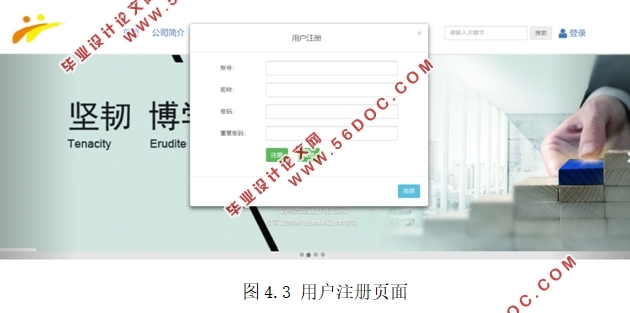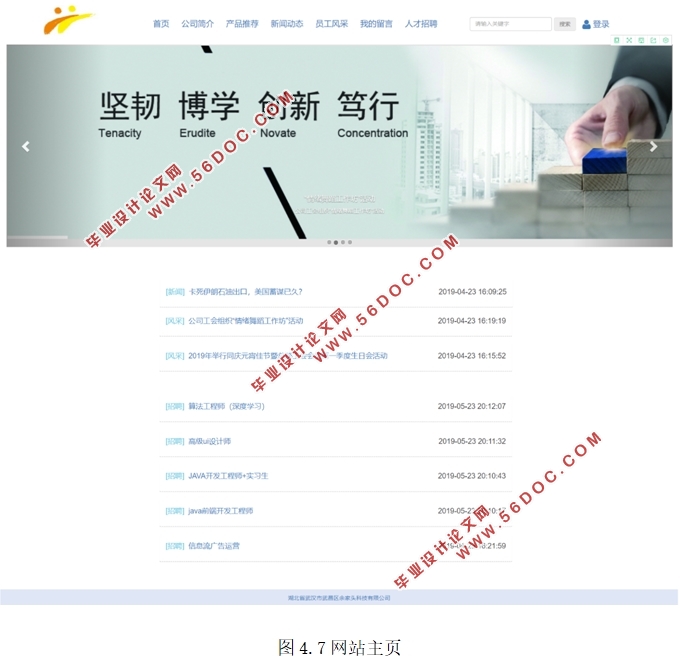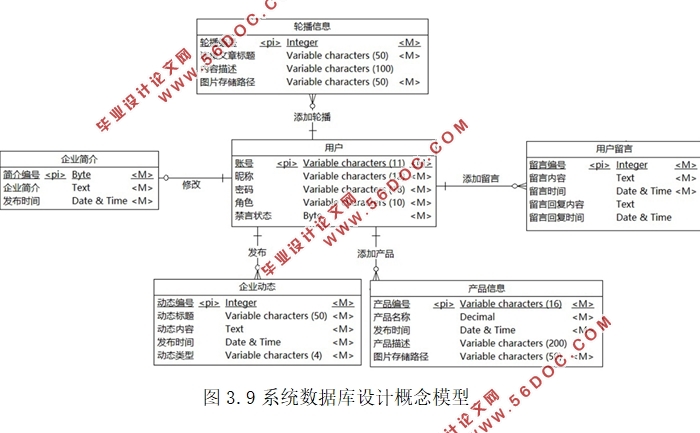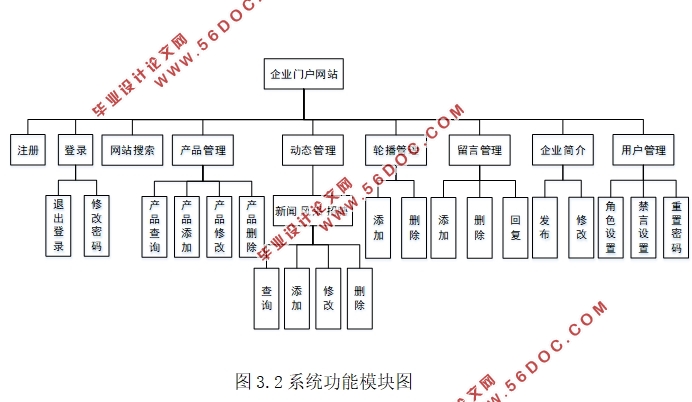基于JavaWeb企业门户网站的设计(SpringBoot,Thymeleaf,Bootstrap,MySQL)(任务书,开题报告,论文18000字,程序代码,MySQL数据库)
摘要
随着互联网的日益发展,传统纸质传单、短信推送等宣传方式已远远不能满足企业的需求,与此同时,企业门户网站高效率、低成本、便于管理的特点得到了越来越多的企业的青睐。企业门户网站主要作为用户与企业之间沟通的桥梁,便于企业宣传、用户了解企业。经过多年发展,企业门户网站无论在规模还是种类方面,都在不断多元化,复杂化,网页数量及丰富度也随之增加,数据安全和用户隐私成为了越来越值得关注的问题。因此,网站开发与维护成本也随之急剧增加。针对以上问题,Java Web技术的发展极大解决了这些难题。
本文综合应用Spring Boot、Thymeleaf、HTML5、Bootstrap开发技术,采用MVC,即Model(模型)-View(视图)-Controller(控制层)设计模式,B/S架构设计,极大解耦了代码之间的依赖关系,使网站便于开发和维护。在企业门户网站功能上,完成了用户注册与登录功能,企业产品、新闻动态、员工风采、招聘信息的添加、修改、查找与删除功能,用户留言与回复的添加和删除功能,企业简介、主页轮播的发布与修改功能,以及用户权限管理功能。为网站用户设置三种不同角色,分别是:普通用户、系统管理员、超级管理员,不同角色拥有不同权限。同时,完成各个页面前端的设计与实现工作。解决了门户网站可扩展性、内容管理、数据安全等问题,使企业在减少运营成本、方便管理的同时,也提高企业用户对企业产品及动态的了解。
关键字:企业门户;MVC设计模式;Java Web;Spring Boot
Abstract
With the growing development of the Internet, traditional paper leaflets, SMS push andother propaganda methods have been far from meeting the needs of enterprises. At the same time, the characteristics of high efficiency, low cost and easy management of enterprise portal websites have been favored by more and more enterprises. The enterprise portal mainly serves as the bridge between the user and the enterprise, facilitates the enterprise propaganda, the user understands the enterprise. After years of development,the enterprise portal has been diversified and complicated in terms of scale and variety, and the number and richness of web pages are also increasing. Data security and user privacy have become more and more worthy of attention. Therefore, the cost of website development and maintenance also increases sharply. The development of Java Web technology has greatly solved these problems.
In this paper, Spring Boot, Thymeleaf, HTML5, Bootstrap development technology, and adopts MVC (Model-View-Controller) design pattern. In the function of the enterprise portal, completed the user registration and login function, enterprise products, news, employee style, recruitment information, user message and reply add, modify, search and delete function, enterprise profile, home page broadcast release and modify function, and user rights management function. Set three different roles for the website users: ordinary users, system administrators, and super administrators. Different roles have different permissions. At the same time, complete the design and implementation of the front end of each pagewhich greatly decouples the dependencies between code and makes the website easy to develop and maintain. Solve the scalability of portal, content management, data security and other issues, so that enterprises can reduce the operating costs, facilitate management, and improve the understanding of enterprise products anddynamics.
Key Words:Enterprise portal; MVC; Java Web; Spring Boot
论文共有六章,主要内容分别为:
第一章:绪论。介绍本课题研究背景及意义、国内外研究现状,简要介绍论文结构。
第二章:系统需求分析。结合第1章对国内外研究现状及对当前企业门户的调研,通过用例图及用例描述分析出系统功能性需求与非功能性需求。
第三章:系统设计。在第2章的基础上,借助流程图介绍各模块设计,用E-R图表述系统数据库设计。
第四章:系统实现。主要从界面实现、类图、关键代码介绍各功能的具体实现。
第五章:系统测试。对系统各模块功能进行黑盒测试。
第六章:总结与展望。总结课题所做的工作及感想,并对网站需要改进的地方做出展望。
2.1需求分析
2.1.1功能性需求
结合当前对现有企业门户网站特点的调研,对企业门户网站做出以下需求分析。
该网站是一个基于B/S架构的Web应用程序,面向的用户为企业网站管理员和企业用户,对于企业网站管理员而言:用于企业宣传平台;对于企业用户而言:用于了解企业。系统用户角色有三种:超级管理员、系统管理员和普通用户。超级管理员可以设置其他用户身份、用户权限、重置用户密码;系统管理员可对网站内容进行增删查改,普通用户可浏览网站内容,不可修改。系统初始只有超级管理员,其他用户身份注册后权限由超级管理员管理。
系统的主要功能包括:
(1) 注册:用户在初始使用网站时可创建个人账号用于登录网站获取相应权限;
(2) 登录:用户根据自己注册信息可登录网站使用相应功能;
(3) 轮播管理:在主界面,轮播图用于展示最新网站最新动态,轮播图可以添加和删除;
(4) 企业简介管理:可以添加及修改企业简介,让企业用户了解企业状况;
(5) 动态管理:通过该功能可发布企业新闻动态、员工风采、招聘信息,向企业用户展示企业最新动态及招聘信息,让企业用户更好了解企业;
(6) 产品管理:企业通过该功能可以发布、宣传产品,让企业用户可以详细了解产品信息;
(7) 留言功能:可以作为企业与用户面对面沟通的桥梁;
(8) 用户管理:超级管理员管理用户权限,有角色设置、禁言设置和重置密码。




目录
第1章绪论 1
1.1研究背景及意义 1
1.2国内外研究现状 1
1.3论文主要工作 2
1.4论文结构 2
第2章系统需求分析 4
2.1需求分析 4
2.1.1功能性需求 4
2.1.2非功能性需求 12
2.2技术方案需求 12
第3章系统设计 14
3.1系统设计原则 14
3.2 架构设计 14
3.3模块划分 15
3.4数据库设计 20
3.4.1系统E-R图 20
3.4.2系统物理表 23
第4章系统实现 26
4.1功能性实现 27
4.1.1注册实现 27
4.1.2登录模块实现 31
4.1.3动态管理模块实现 34
4.1.4轮播管理模块实现 38
4.1.5用户管理模块实现 40
4.1.6产品管理模块实现 41
4.1.7系统留言与回复模块实现 41
4.2非功能性实现 41
4.2.1身份过滤 41
4.2.2文件虚拟路径映射 42
4.2.3网站异常处理 42
第5章系统测试 43
5.1测试方法与测试环境 43
5.2测试用例和测试结果 43
5.2.1功能性测试 43
5.2.2非功能性测试 48
第6章总结与展望 50
6.1工作总结 50
6.2工作展望 50
参考文献 51
致谢 52
|









